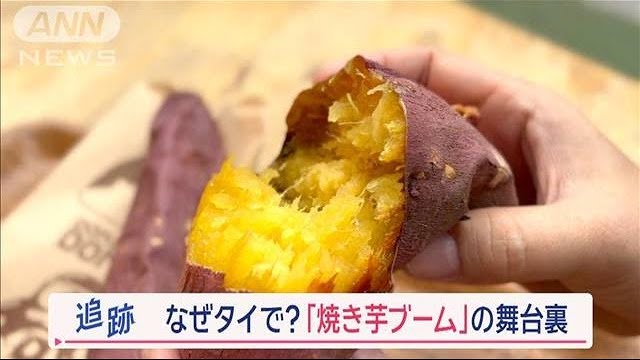BANGKOK, Feb 19 (News On Japan) - In tropical Thailand, a culinary phenomenon is taking place: the Japanese "yakiimo" or roasted sweet potato. This humble snack has undergone a remarkable evolution in Thailand, captivating the nation with its sweetness and texture.
Global Spotlight on Japan's Sweet Yakiimo
In Tokyo's Asakusa, long queues form for a taste of this sweet delight. Visitors from around the world rave about its flavor:
Visitor from Australia: "It's incredibly delicious!"
Visitor from America: "It's really sweet and tasty!"
Japan's sweet yakiimo is gaining international attention, with events in Hong Kong witnessing a rush for Japanese sweet potatoes. Tasting events are also being held in London and Dubai.
But how are these sweet potatoes exported? Our team headed to Miyazaki Prefecture, a major production area, to find out.
At Kushima Aoi Farm, President Yosuke Narasako shows us the storage facility, housing a staggering 1,000 tons of sweet potatoes, equivalent to about 4 million pieces. The "Beni Haruka" variety, harvested last year, is exported to Europe and Asia throughout the year, maintaining its quality.
Thailand's Yakiimo Boom: The Role of Don Quijote
Thailand is experiencing a sweet potato fever, with exports from Japan increasing sixfold in five years. In Bangkok's supermarkets, Japanese sweet potatoes, labeled "AMAIMO," are found right behind the king of fruits, durian. Despite being priced at around 500 yen each, these roasted sweet potatoes sell out quickly, with up to 300 sold daily.
A regular Thai customer expresses their love for the creamy texture and sweetness, noting that such sweet potatoes are not found in Thailand.
The catalyst for this boom was the popular Japanese store, Don Quijote. Five years ago, it introduced Japanese yakiimo to Thailand, and it became an instant hit.
Regular Thai customers were initially skeptical about the sweetness, suspecting added sugar, but now they can't get enough of it.
Since then, yakiimo has evolved uniquely in Thailand, with specialty stores popping up. One popular variation involves sprinkling sugar on the yakiimo and torching it with a gas burner before adding gold leaf.
Some stores offer a unique Thai twist: frozen yakiimo, eaten like sherbet ice. Other popular items include yakiimo ice latte, yakiimo Mont Blanc ice cream, and chilled yakiimo, showcasing the versatility of this treat in a tropical climate.
The Secret to Japanese Yakiimo's Sweetness: 3–6 Months of Maturation
The key to the popularity of Japanese yakiimo lies in its sweetness. But what makes it so sweet?
We visited a company in Miyazaki Prefecture that exports yakiimo to Thailand. According to President Kenji Sugou of SAZANKA, the maturation process is crucial. The sweet potatoes are matured for 3 to 6 months, undergoing a transformation that enhances their sweetness.
In the storage facility, the sweet potatoes are matured in soil at a strict humidity of 95% and a temperature of 14°C. Over several months, the starch inside the sweet potatoes is broken down into sugar, significantly increasing their sweetness. Unfortunately, the final stage of maturation is a closely guarded secret.
When these matured sweet potatoes are roasted, they become incredibly sweet, with syrup oozing out.
Yakiimo's Popularity Extends to Alcoholic Pairings
While Thailand has its own sweet potatoes, the traditional way of eating them is as "fukashi-imo," sold at street stalls. The sweetness level of these is around 7 degrees Brix, whereas the Japanese yakiimo we tasted earlier has a sweetness level of 60 degrees Brix, comparable to strawberry jam.
Now, the yakiimo craze in Thailand is extending beyond sweets. There's a popular yakiimo dish that pairs well with alcohol, made from the same 60 degrees Brix sweet potatoes.
Shinji Hara, Executive Chef at 1923, comments on the surprising sweetness of the dish.
The dish in question? Yakiimo tempura. Slicing the sweet potatoes, coating them in flour, and frying them enhances their sweetness, making them a hit with the younger generation in Thailand.
Regular Thai customers praise its sweetness and compatibility with alcohol.
Another popular dish among Thai women is yakiimo with cheese. The
combination of the sweet potato's sweetness and the cheese's saltiness has created a surge of repeat customers.
Behind the Yakiimo Boom: The Japanese Innovators
Behind the expanding yakiimo boom in Thailand are Japanese innovators. Hibiki Omori, 28, left university at 21 with the ambition of spreading Japan's superior food ingredients worldwide. He joined a consulting company in Thailand and has since developed yakiimo-based menus for 60 restaurants in Bangkok.
Omori finds great satisfaction in introducing something new to Thais and seeing their delighted reactions.
On this day, a tasting session for a new product was held. Omori and his Thai staff were experimenting with "yakiimo French fries." They tested various powders, such as barbecue and cheese flavors, to see which would suit Thai tastes.
The staff found that the combination of barbecue flavor and the sweetness of yakiimo worked well. Based on the tasting results, they decided to add barbecue and cheese-flavored yakiimo fries to the menu.
Yakiimo Meets Thai Cuisine: A Match Made in Culinary Heaven
Meanwhile, Thai innovators are also exploring the fusion of yakiimo and Thai cuisine. Chef On of Café Rabbits believes that the combination of Japanese yakiimo and Thai cuisine is perfect.
One popular dish is a salad made with fried yakiimo, tossed in a spicy and sour Thai dressing. The basic elements of Thai cuisine—spiciness, sourness, and sweetness—harmonize wonderfully with the sweetness of Japanese yakiimo.
On sees "infinite possibilities" in the combination of yakiimo and Thai cuisine.
The café also offers a green curry with yakiimo, which has become a signature dish.
Regular Thai customers are pleasantly surprised by how well Japanese yakiimo complements Thai cuisine.
At another Thai restaurant, The Rabbit's Grove Café & Restaurant, owner Nok chose Japanese sweet potatoes for their sweetness, which he believed would appeal to Thais.
One of the restaurant's signature dishes is "Satsumaimo Massaman Curry." While the traditional Massaman curry uses potatoes, the use of Japanese sweet potatoes, which are a relatively new ingredient in Thailand, has made this dish a standout on the menu.
Regular Thai customers rave about the perfect balance of the curry's spiciness and the sweet potato's sweetness, describing it as "delicious" and "blissful."
The encounter between Thai cuisine and Japanese yakiimo has opened up new possibilities for this beloved snack.
Regular Thai customers hope that people in Japan will also get a chance to savor these innovative dishes, showcasing the cross-cultural culinary exchange between Japan and Thailand.
Source: ANN



 by
by 












